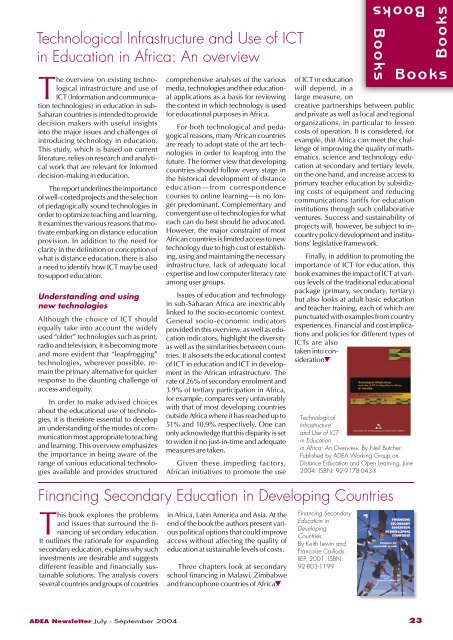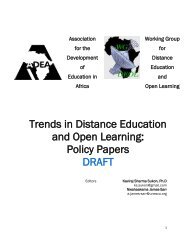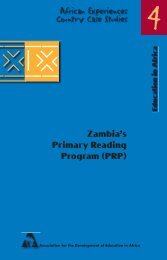Newsletter Vol.16 No.3 - ADEA
Newsletter Vol.16 No.3 - ADEA
Newsletter Vol.16 No.3 - ADEA
Create successful ePaper yourself
Turn your PDF publications into a flip-book with our unique Google optimized e-Paper software.
Technological Infrastructure and Use of ICTin Education in Africa: An overviewThe overview on existing technologicalinfrastructure and use ofICT (Information and communicationtechnologies) in education in sub-Saharan countries is intended to providedecision makers with useful insightsinto the major issues and challenges ofintroducing technology in education.This study, which is based on currentliterature, relies on research and analyticalwork that are relevant for informeddecision-making in education.The report underlines the importanceof well-costed projects and the selectionof pedagogically sound technologies inorder to optimize teaching and learning.It examines the various reasons that motivateembarking on distance educationprovision. In addition to the need forclarity in the definition or conception ofwhat is distance education, there is alsoa need to identify how ICT may be usedto support education.Understanding and usingnew technologiesAlthough the choice of ICT shouldequally take into account the widelyused “older” technologies such as print,radio and television, it is becoming moreand more evident that “leapfrogging”technologies, wherever possible, remainthe primary alternative for quickerresponse to the daunting challenge ofaccess and equity.In order to make advised choicesabout the educational use of technologies,it is therefore essential to developan understanding of the modes of communicationmost appropriate to teachingand learning. This overview emphasizesthe importance in being aware of therange of various educational technologiesavailable and provides structuredcomprehensive analyses of the variousmedia, technologies and their educationalapplications as a basis for reviewingthe context in which technology is usedfor educational purposes in Africa.For both technological and pedagogicalreasons, many African countriesare ready to adopt state of the art technologiesin order to leapfrog into thefuture. The former view that developingcountries should follow every stage inthe historical development of distanceeducation—from correspondencecourses to online learning—is no longerpredominant. Complementary andconvergent use of technologies for whateach can do best should be advocated.However, the major constraint of mostAfrican countries is limited access to newtechnology due to high cost of establishing,using and maintaining the necessaryinfrastructure, lack of adequate localexpertise and low computer literacy rateamong user groups.Issues of education and technologyin sub-Saharan Africa are inextricablylinked to the socio-economic context.General socio-economic indicatorsprovided in this overview, as well as educationindicators, highlight the diversityas well as the similarities between countries.It also sets the educational contextof ICT in education and ICT in developmentin the African infrastructure. Therate of 26% of secondary enrolment and3.9% of tertiary participation in Africa,for example, compares very unfavorablywith that of most developing countriesoutside Africa where it has reached up to51% and 10.9% respectively. One canonly acknowledge that this disparity is setto widen if no just-in-time and adequatemeasures are taken.Given these impeding factors,African initiatives to promote the useBooksBooksof ICT in educationwill depend, in alarge measure, oncreative partnerships between publicand private as well as local and regionalorganizations, in particular to lessencosts of operation. It is considered, forexample, that Africa can meet the challengeof improving the quality of mathematics,science and technology educationat secondary and tertiary levels,on the one hand, and increase access toprimary teacher education by subsidizingcosts of equipment and reducingcommunications tariffs for educationinstitutions through such collaborativeventures. Success and sustainability ofprojects will, however, be subject to incountrypolicy development and institutions’legislative framework.Finally, in addition to promoting theimportance of ICT for education, thisbook examines the impact of ICT at variouslevels of the traditional educationalpackage (primary, secondary, tertiary)but also looks at adult basic educationand teacher training, each of which arepunctuated with examples from countryexperiences. Financial and cost implicationsand policies for different types ofICTs are alsotaken into consideration.▼TechnologicalInfrastructureand Use of ICTin Educationin Africa: An Overview. By Neil Butcher.Published by <strong>ADEA</strong> Working Group onDistance Education and Open Learning, June2004. ISBN: 92-9178-043-XFinancing Secondary Education in Developing CountriesThis book explores the problemsand issues that surround the financingof secondary education.It outlines the rationale for expandingsecondary education, explains why suchinvestments are desirable and suggestsdifferent feasible and financially sustainablesolutions. The analysis coversseveral countries and groups of countriesin Africa, Latin America and Asia. At theend of the book the authors present variouspolitical options that could improveaccess without affecting the quality ofeducation at sustainable levels of costs.Three chapters look at secondaryschool financing in Malawi, Zimbabweand francophone countries of Africa.▼Financing SecondaryEducation inDevelopingCountries.By Keith Lewin andFrancoise Caillods.IIEP, 2001. ISBN:92-803-1199BooksBooks<strong>ADEA</strong> <strong>Newsletter</strong> July - September 200423
















